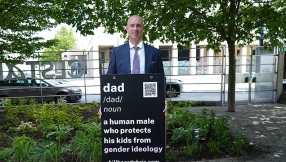The jury's out on the latest New International Version
Publishers of the New International Version, Biblica and Zondervan, debuted an online version of the new NIV Bible earlier this month on Biblica.com and BibleGateway.com. A print version is slated for release March 2011 when the current NIV translation will be discontinued.
In the new NIV Bible, the Committee for Bible Translation – translators of the NIV – put back in some passages masculine pronouns,including "son", "he", "him", "his", "father", and "brother", that had been replaced with gender-neutral terms in the 2005 TNIV (Today's International Version). The New Testament of the TNIV was released in 2002.
The Council on Biblical Manhood and Womanhood, one of the leading critics of the TNIV, of which the new translation was based on, said the latest NIV translation showed "significant improvements" over the TNIV but still contained major errors.
"Our initial analysis shows that the new NIV(2011) retains many of the problems that were present in the TNIV, on which it is based, especially with regard to the over 3,600 gender-related problems we previously identified," said CBMW in a statement.
"In spite of the many good changes made, our initial analysis reveals that a large percentage of our initial concerns still remain."
Back in 2002, CBMC released a statement opposing the TNIV that was endorsed by at least 110 ministry leaders, including evangelicals Mark Strauss of Bethel Seminary San Diego and popular author Philip Yancey.
The council acknowledged that some changes like references to “man” and “mankind” instead of a gender-neutral equivalent resulted in greater accuracy in translating the Hebrew or Greek text.
However, CBMW took issue with the CBT's approach to remedy the gender-neutral dispute in many passages by neither siding with the 1984 NIV nor the TNIV but by taking a middle ground.
In Revelations 3:20, for instance, the CBT did not use masculine singulars (him, he) as found in the NIV nor gender-neutral plurals (them, they) but mixed gender-unspecific singulars and plurals (that person/they).
Revelations 3:20
NIV(1984): Here I am! I stand at the door and knock. If anyone hears my voice and opens the door, I will come in and eat with him, and he with me.
TNIV(2005): Here I am! I stand at the door and knock. If anyone hears my voice and opens the door, I will come in and eat with them, and they with me.
NIV(2011): Here I am! I stand at the door and knock. If anyone hears my voice and opens the door, I will come in and eat with that person, and they with me.
The use of plurals in some text will confuse readers and leave pastors and teachers with the "onerous task" of reminding their listeners whether "they" is meant as singular or plural, stated CBMW.
Not all evangelicals are objecting to the revisions in the new NIV Bible.
Darrell L Bock, Research Professor for New Testament Studies at Dallas Theological Seminary, told The Christian Post that he believes the newest rendering of the NIV is a "solid translation".
Around the time of the CBMW statement eight years ago, Bock wrote an article entitled, "Do Gender Sensitive Translations Distort Scripture? Not Necessarily." In the writing, Bock looked at the way in which gender-related passages should be handled and showed how some complaints at the time were not justified.
He said he kept a list of disputed passages – including Genesis 1:26, Ephesians 6:1-4, and 1 Timothy 2:5 – from the TNIV and compared them to the updated NIV.
Bock said that in many cases, the changes in the new NIV "improved the clarity of the rendering even from before."
Genesis 1:26
NIV(1984): Then God said, “Let us make man in our image, in our likeness...
TNIV(2005): Then God said, "Let us make human beings in our image, in our likeness ..."
NIV(2011): Then God said, "Let us make mankind in our image, in our likeness ... "
Also happy with the result, CBT Chair Professor Douglas Moo said the updated NIV represents the "optimum combination of transparency to the original documents and comprehensibility" for a broad audience.
“When the books of the Bible were first written, they captured exactly what God wanted to say in the languages and idioms used by the ordinary people of the time” said Moo.
“The NIV seeks to recover these priorities, allowing readers to perceive the structure of the original and the meaning of the original at the same time. The changes we have made in the update maintain and strengthen this focus, reflecting progress in biblical scholarship, developments in English usage, and an ongoing concern for clarity.
"We have also used new tools, drawing on state- of- the- art computational linguistic research to guide us in our decision-making and to ensure that the words we choose maximise comprehension of the original meaning.”
Still, CBMW said it is unable to commend the new NIV. It noted that other translations did a better job of handling gender-related language than the TNIV and new NIV. They include: Holman Christian Standard Bible (HCSB), the New American Standard (NASB), the New King James (NKJV), and the English Standard Version (ESV).
But its complaints were not limited to gender-related passages. The CBMW said the new NIV's rendering of beloved passages like Psalm 23 could alone present challenges in its path to gain wider acceptance. The familiar phrase "valley of the shadow of death" found in verse 4 is replaced by the words "darkest valley" – a holdover from the TNIV.
CBMW plans to release an exact percentage of the problems that remain in the new translation compared to the TNIV after it completes a full detailed analysis.













